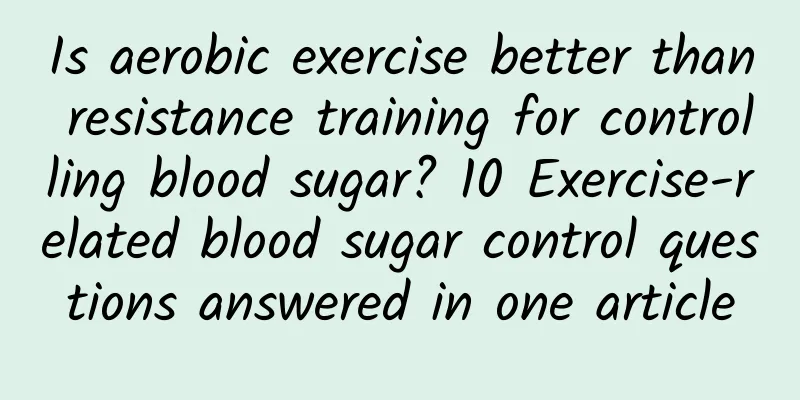Is aerobic exercise better than resistance training for controlling blood sugar? 10 Exercise-related blood sugar control questions answered in one article

|
Many people are worried about the rise in blood sugar after eating delicious food. During festivals and reunions, people have to enjoy a big meal. In addition to medication, arranging physical activities properly is also an important measure to control blood sugar . How can exercise help control blood sugar after meals? Here are the answers to 10 questions that netizens are most concerned about. If you don't want to read the long content at the beginning, you can turn to the back of the article to read the summary. Question 1: To control blood sugar, is it better to do aerobic exercise or resistance training? Answer: Both aerobic exercise and resistance training are beneficial for controlling postprandial blood sugar. Research evidence shows that when compared with the same duration and intensity, the blood sugar-lowering effects of the two types of exercise are not much different. Aerobic exercise, such as brisk walking, jogging, and cycling , can effectively reduce post-meal blood sugar. Studies have shown that 30 minutes of moderate-intensity aerobic exercise after a meal can significantly improve blood sugar levels. Even a 10-15 minute walk after a meal can effectively reduce blood sugar peaks (Colberg et al, Diabetes Care, 2016). Even regular leg shaking while sitting for a long time can be beneficial to blood sugar control. Most people with poor blood sugar control have problems such as poor physical strength, decreased endurance, and easy fatigue. If physical strength permits, gradually improving aerobic endurance will help reduce body fat percentage, reduce intramuscular fat and liver fat, and thus improve insulin sensitivity. However, it should be noted that aerobic exercise will not cause muscle loss when the calories and nutrients are adequately supplied. However, doing long-term aerobic exercise under hungry conditions may cause muscle loss, which is not conducive to blood sugar control. On the other hand, resistance training such as weightlifting, machines, and elastic band exercises can increase muscle mass, enhance muscle strength, and improve insulin sensitivity, thereby helping to control blood sugar stability after meals. However, strengthening muscles does not mean that you must go to the gym to do machine exercises. For people who have never done any exercise and have poor muscle strength, even if they do squats, dumbbell lifting, sit-ups, elastic band pulling and other exercises at home, they can also exercise their muscles. Here is a reminder that while exercising muscles, you must also pay attention to ensuring the supply of protein and staple foods, because muscle gain requires additional nutritional support. Question 2: When is the best time to exercise? Should I exercise on an empty stomach before or after a meal? Answer: When it comes to controlling post-meal blood sugar, exercise before and after meals both have their benefits. The main source of glucose for pre-meal exercise is the breakdown of liver glycogen and gluconeogenesis . For healthy people, blood sugar regulation during fasting exercise does not rely on the action of insulin, which is beneficial to improve insulin sensitivity and promote fat decomposition, and will not cause discomfort during exercise due to gastrointestinal heaviness. Limited research shows that whether diabetic patients exercise on an empty stomach or after eating, there is no difference in improving metabolic health and lowering glycated hemoglobin levels (Edinburgh et al, Journal of Physiology, 2022). However, more studies have confirmed that post-meal activities are more effective than pre-meal exercise in controlling post-meal blood sugar levels, whether for healthy people or diabetic patients. This is because blood sugar levels are high within 2 hours after a meal, and exercise can effectively reduce blood sugar peaks. Studies have long found that 30 minutes of moderate-intensity exercise immediately after a meal can significantly reduce blood sugar levels (Manders et al., Diabetologia, 2010). The energy source for post-meal exercise is mainly glucose absorbed from food . Muscles absorb glucose when they contract, which reduces insulin secretion and increases incretin secretion. In terms of the start time of exercise, it is ideal to start activity before the blood sugar peak. The latest meta-analysis shows that starting activity within 1 hour after a meal can achieve the best blood sugar control effect (Kang et al, Nutrients, 2023). The so-called 1 hour after a meal is the time from the first bite of food , not the time from the end of the meal. For healthy people, the peak of blood sugar after a meal usually occurs between 30 and 60 minutes after a meal, and the usual meal time is between 15 and 30 minutes, so for most people, the peak of blood sugar occurs shortly after a meal. If it is a marathon banquet, the blood sugar peak may occur before leaving the table, and the time to reduce the peak of blood sugar after a meal by exercise has passed. Question 3: Is it better to exercise in the morning or in the evening? According to traditional Chinese health care, it is believed that the morning is the time when "yang energy is generated" and is suitable for exercise; while the evening is a time when one needs to concentrate and is not suitable for strenuous exercise. Many studies have shown that long-term and regular morning fasting exercise is beneficial for improving blood sugar metabolism (Edinburgh et al, Journal of Physiology, 2022). However, when people with unstable blood sugar levels first start fasting exercise, they must pay attention to gradual progress to avoid the risk of hypoglycemia. However, for office workers, who have to work during the day and have no time to exercise in the morning when they have a long commute, exercising at 8 or 9 o'clock in the evening may be the easiest option to arrange. A smaller study published in 2022 found that exercising at night may be more effective for improving insulin resistance and preventing diabetes in patients with diabetes (van der Velde et al, Diabetologia, 2022). Whether to exercise in the morning or evening depends entirely on each person's lifestyle, body response, and the type of exercise. The best time to exercise is when your body responds well and it is easy to stick to it for a long time. Question 4: Can I exercise right after a meal? Don’t health experts say that I should sit down and wait for half an hour before exercising? Answer: According to current research evidence, for healthy people, starting physical activity only 10 to 15 minutes after a meal is more effective in reducing postprandial blood sugar peaks than resting for 30 minutes after a meal before exercising (Bellini et al., 2021). For people with normal digestive ability and physical fitness, it is no problem to do low-intensity exercise such as walking, taking a walk, or doing simple housework immediately after a meal. Don’t uncles and aunts wash dishes and clean the house immediately after a meal? Don’t many office workers have to ride bicycles or take the subway to work immediately after breakfast? Don’t service staff have to continue working soon after lunch? Don’t people who go to tourist attractions eat some food they brought with them on the way and then continue hiking and walking? However, the specific exercise time and intensity vary from person to person. For the weak, the elderly, and those with digestive system diseases or food intolerance, the time and intensity of post-meal exercise may need to be adjusted. If the stomach feels heavy after a meal, and you feel your heartbeat and breathing become rapid even when walking at a normal speed, then you can postpone the exercise time, sit down and rest quietly, and then exercise after the burden on the stomach is reduced. When exercising, pay attention to your heart rate changes. If your heart rate is higher than usual during the same exercise, reduce the intensity of the exercise. In addition, in addition to postponing physical activities, the weak and those with indigestion should not do strenuous brain work immediately after a meal, and should not talk too much, so as to concentrate on digestion. Question 5: The blood sugar peak of diabetic patients is delayed. Is it best to start exercising right after a meal? A: For diabetic patients, the post-meal blood sugar peak is often delayed, often occurring between 60 and 120 minutes after a meal. According to current research results, diabetic patients with adequate physical strength can still achieve greater reductions in blood sugar peaks by starting physical activity for 15 to 30 minutes before the blood sugar peak (30 minutes after a meal) (Bellini et al, Nutrients, 2021). The same is true for resistance exercise. The benefits of starting exercise 45 minutes after a meal are greater than those of exercising before a meal (Heden et al, Journal of Applied Physiology, 2015). Of course, whether you exercise before or after a meal, the effect of exercise may be affected by many factors, such as digestive capacity, nutritional status, exercise intensity, and exercise volume. The best exercise time and intensity are definitely different for each individual, and are not necessarily 30 to 60 minutes after a meal (counting from the first bite of food). You need to observe and determine it yourself. Question 6: How intense should the post-meal exercise be? Does it need to be something like running? A: High-intensity exercise such as running and jumping is not necessary. Studies have shown that moderate-intensity exercise is the best for controlling post-meal blood sugar, which is better than high-intensity exercise. For diabetic patients, high-intensity exercise after a meal has the risk of causing hypoglycemia, so it is best to perform it with caution while monitoring blood sugar levels (Yardley et al., Journal of Sports Science & Medicine, 2012). The so-called exercise intensity is not evaluated by speed, but by heart rate . The maximum heart rate of exercise is 220-age, and this difference × 60% is approximately the heart rate of moderate-intensity exercise. For example, a 50-year-old person has a maximum heart rate of 220 - 50 = 170. 170 × 60% = 102. Therefore, a heart rate of 102 during exercise is considered moderate intensity. Wear a sports watch or smart watch to know your heart rate. Generally speaking, moderate-intensity exercise can make the body warm up slowly, but it is relatively relaxing overall and can be sustained for a long time without causing breathlessness, sweating, or feeling your heart beating fast. Everyone has different physical fitness. For those who are weak or have poor digestion, even taking a walk after a meal can reach this heart rate level, without running or jumping. In addition, even if you can't reach the exercise heart rate, just going out to buy groceries or pick up a package after a meal, as long as you can walk for a few minutes to ten minutes, the blood sugar peak will be lower than sitting still. Question 7: Do I have to go out and exercise after a meal? Is it okay to exercise at home or do housework? A: Doing some light housework at home can also help control blood sugar . Some friends found that after wearing a continuous blood glucose meter, running, brisk walking, and other exercises with higher intensity may temporarily increase blood sugar due to stress; while cleaning, mopping the floor, and tidying up the house after a meal, blood sugar is the most stable. In fact, this is low- to medium-intensity indoor exercise. Because this type of activity takes a long time, If this is the case, you can use indoor activities such as housework to replace outdoor exercise. However, it should be considered that outdoor exercise can increase the production of vitamin D, and sufficient vitamin D is beneficial for controlling sugar, losing weight, and improving disease resistance. At the same time, outdoor light is also beneficial for regulating circadian rhythms, improving mood, and reducing insomnia. Therefore, it is best to go out twice a day and see the sun . Question 8: How long should I exercise after a meal to effectively control blood sugar? A: my country's diabetes dietary guidelines and international literature recommend that patients with type 2 diabetes should exercise at least 30 minutes of moderate intensity every day. On the basis of ensuring at least 30 minutes of exercise every day, doing low- to moderate-intensity exercise after each of the three meals may achieve better results. Compared with sitting still, even walking for 10 to 15 minutes can play a role in reducing blood sugar peaks. In terms of controlling post-meal blood sugar, it is recommended that healthy people exercise for at least 15 minutes after a meal, and patients with type 2 diabetes for at least 30 minutes. According to current evidence, 30 to 60 minutes is the most effective (Bellini et al, Nutrients, 2024). It can be low- to medium-intensity activities that can effectively control blood sugar without excessive fatigue. A meta-analysis of studies on post-meal exercise found that for patients with diabetes, 60 minutes of post-meal exercise is more effective (Kang et al, Nutrients, 2023). For diabetic patients, insisting on at least 30 minutes of moderate-intensity exercise every day is a long-term requirement . Its role is not limited to controlling blood sugar after meals, but more to improving blood circulation, preventing various cardiovascular complications, strengthening muscles, reducing body fat percentage, and thus improving insulin sensitivity. Question 9: Post-meal exercise will increase blood sugar peak and cause blood sugar rebound. Why? Answer: For some patients with type 2 diabetes or prediabetes who have poor digestion and blood sugar control, although post-meal exercise can reduce blood sugar peaks, it may also cause a temporary increase in blood sugar during exercise and a rebound in blood sugar after exercise, resulting in multiple blood sugar peaks and reducing the beneficial effects of exercise (Chacko et al, Scientifica, 2016). Therefore, many diabetic patients say that their blood sugar levels will soar after they start exercising, and only after a period of exercise will their blood sugar levels start to drop. Although intense exercise such as running, jumping, and playing ball consumes blood sugar, it also causes adrenaline secretion, which temporarily pushes up blood sugar. In comparison, this is not likely to happen with low- and medium-intensity exercise. It is also common to experience a rebound in blood sugar after exercise . On the one hand, exercising immediately after a meal may cause a temporary decrease in the function of the digestive system, and at the same time consume blood sugar during exercise, leading to lower blood sugar levels; but after stopping exercise and continuing digestion, the glucose produced by food digestion is absorbed into the blood, forming a second larger blood sugar peak. On the other hand, the peak of insulin secretion plus high-intensity exercise will cause blood sugar to drop rapidly, even below normal levels, which may cause a stress response in the body and promote gluconeogenesis, leading to a rebound in blood sugar levels. If this type of problem exists, you can consider trying a few measures: patients with poor digestion should avoid eating too much difficult-to-digest food to reduce the gastrointestinal burden; only do light activities at the end of a meal, and postpone the moderate intensity time to 2 hours after the meal; you can also reduce the intensity of exercise to avoid physical stress. Although lower-intensity exercise may also bring about a second blood sugar peak, it is usually lower than the first peak, reducing the overall fluctuation of blood sugar after a meal. Question 10: Will it be effective if I do not do continuous long-term exercise after a meal but just exercise for a few minutes at a time in small amounts and multiple times? A: For those who cannot continue to exercise for various reasons, you can also consider dividing the post-meal exercise into several small segments, each lasting a few minutes, and exercising every half an hour. Many studies have shown that intermittent exercise of the same total length can even have a better blood sugar stabilization effect than continuous long-term exercise. For patients who take medication, the amount of carbohydrates they eat and the duration of action of the medication must also be considered. If carbohydrate intake is too low, or the blood sugar-lowering effect of exercise overlaps with the blood sugar-lowering effect of medication, there is a greater risk of hypoglycemia during exercise. Finally, let’s summarize. Based on current research evidence, the following suggestions are made for blood sugar control exercises: If you have normal blood sugar levels, the purpose of exercising to control blood sugar is to lose weight and reduce fat more efficiently. You can exercise before or after meals, both of which are beneficial for fat loss and blood sugar control. For people with normal digestive ability who want to reduce the post-meal blood sugar peak , current research evidence best supports at least 15 minutes, and preferably 30 minutes, of moderate-intensity aerobic exercise or resistance training starting 30 minutes to 1 hour after a meal. For patients with type 2 diabetes , physical activity for 30 to 60 minutes within 1 hour after a meal is also good for controlling blood sugar after a meal. However, it is important to control the intensity of the exercise to avoid hypoglycemia during exercise and a sharp rebound in blood sugar after exercise. It is best to wear a continuous blood glucose meter to observe changes in blood sugar during exercise. There is no limit to the specific form of activity, aerobic exercise, resistance exercise, or a combination of the two. If you cannot exercise continuously at a moderate intensity, you can break the exercise into 3-5 minute segments, repeat it, and reach a total of 30-60 minutes, which also has a good effect. If your digestive ability is weak and exercising immediately after a meal is not effective, you can consider doing low-intensity exercises such as light housework after the meal, and then engage in intense exercise after there is no obvious burden on your stomach. Regardless of the type of person, it is advisable to have at least 30 minutes of medium/high intensity exercise every day to strengthen muscles, improve insulin sensitivity, and enhance cardiopulmonary function. Intensive exercise can be done in the morning or evening, depending on whether the body feels comfortable, blood sugar is relatively stable, and it is easy to stick to it for a long time. (The time for taking a walk after a meal and doing light housework is not included in the 30 minutes.) In addition, for patients who take medication, the relationship between medication and exercise is not well understood. In order to maintain blood sugar stability and facilitate drug control, doctors usually recommend that diabetic patients have a fixed amount of carbohydrates per meal. However, the blood sugar response after a meal does not only depend on the amount of carbohydrate food intake, but also many other factors, even the impact of the previous meal and the impact of pre-meal activities, which makes prediction very difficult. Therefore, it is best to have a doctor or professional coach provide precise guidance and regular adjustments based on the individual's age, physical condition, lifestyle and exercise ability, and according to the data of the continuous blood glucose meter. References: 1 Bellini A, Scotto di Palumbo A, Nicolò A, Bazzucchi I, Sacchetti M. Exercise Prescription for Postprandial Glycemic Management. Nutrients. 2024;16(8):1170. 2 Bellini, A.; Nicolò, A.; Bulzomì, R.; Bazzucchi, I.; Sacchetti, M. The Effect of Different Postprandial Exercise Types on Glucose Response to Breakfast in Individuals with Type 2 Diabetes. Nutrients. 2021, 13, 1440. 3 Bellini, A.; Nicolò, A.; Bazzucchi, I.; Sacchetti, M. Effects of Different Exercise Strategies to Improve Postprandial Glycemia in Healthy Individuals. Medical Science and Sports Exercise. 2021, 53, 1334–1344. 4 Chacko, E. Exercising Tactically for Taming Postmeal Glucose Surges. Scientifica 2016, 2016, 4045717. 5 Edinburgh, RM; Koumanov, F.; Gonzalez, JT Impact of Pre-exercise Feeding Status on Metabolic Adaptations to Endurance-type Exercise Training. J. Physiol. 2022, 600, 1327–1338. 6 Gisela Arsa 1, Laila Cândida de Jesus Lima 2, Daisy Motta-Santos 3, Lucieli Teresa Cambri 1, Carmen Silvia Grubert Campbell 4, John Eugene Lewis 5, Herbert Gustavo Simões. Effects of prior exercise on glycemic responses following carbohydrate ingestion on in individuals with type 2 diabetes. Journal of Clinical and Translational Research. 2015;1(1):22-30. 7 Heden, TD; Winn, NC; Mari, A.; Booth, FW; Rector, RS; Thyfault, JP; Kanaley, JA Postdinner Resistance Exercise Improves Postprandial Risk Factors More Effectively than Predinner Resistance Exercise in Patients with Type 2 Diabetes. Journal of Applied Physiology. 2015, 118, 624–634. 8 Kang J, Fardman BM, Ratamess NA, Faigenbaum AD, Bush JA. Efficacy of Postprandial Exercise in Mitigating Glycemic Responses in Overweight Individuals and Individuals with Obesity and Type 2 Diabetes-A Systematic Review and Meta-Analysis. Nutrients. 2023;15(20):4489. |
<<: “Olive oil is the best oil” “Olive oil is a waste of money”? The answer is…
>>: What happens when a black hole passes close to the Earth?
Recommend
The difference between TV and box
Abstract: Because both can watch TV and videos, e...
How does operations perform data analysis? 3 ideas and 8 methods!
I've been reading "Chief Growth Officer&...
2017 B2B Industry Content Marketing White Paper: How to Disseminate Content Effectively?
With good content, you are qualified to stand at ...
Who was the richest student of Confucius? Without him, there would be no Analects!
Mixed Knowledge Specially designed to cure confus...
iPhone 8/8 Plus real machine pictures, iPhone X real machine pictures and hands-on videos
While everyone was shouting that the iPhone X was...
Outlook for 2016: The electronics industry continues to embrace the Internet of Things
Time flies, and a new year has arrived. The elect...
Teach you to use your eyes to play with your phone
When you play with your phone for a long time, wh...
Can WeChat be used like this? Hidden WeChat operations that will open your eyes
WeChat is used every day, but do you know how man...
The core ideas and 14 practical methods of Weibo promotion
Weibo promotion uses Weibo as a promotion platfor...
Will the lake on the "Roof of the World" expand by 50%? More water is not necessarily a good thing...|Expo Daily
Lakes on the Qinghai-Tibet Plateau are expected t...
Hupu product analysis report!
On June 6, 2019, Hupu Sports Community received a...
Visual Studio 2015 will be released on July 20
[[138348]] Microsoft has announced that the offic...
Advertising placement: An optimizer’s guide to avoiding pitfalls!
Working in the optimization industry, I deal with...
Samsung GALAXY Alpha review: metal frame feels great
In previous rumors, Samsung GALAXY Alpha has alwa...









